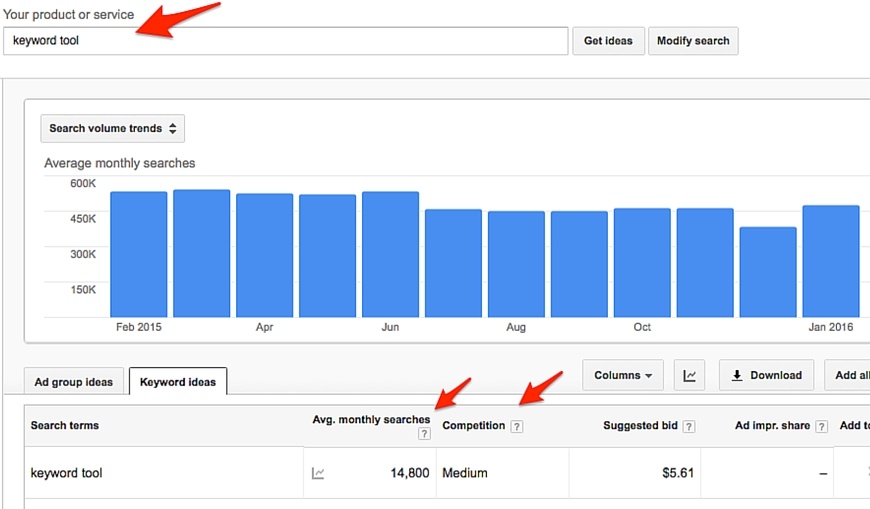Keywords still matter. And understanding how to do keyword research is as important as writing a blog post. This is the first post in a series about how to do keyword research for your blog with a keyword planner.

The free, granddaddy keyword tool of them all is Google Adwords’ Keyword Planner. Sure, there are a bunch of paid keyword tools out there, but for someone just getting started in keyword research, Google Adwords’ Keyword Planner (KP, for short and moving forward in this post) is the ideal place to start.
Getting Started
To use KP, you’ll need to set up a Google Adwords account first. The good news is that you don’t need to be running Google Adwords to use KP. You just need to set up an account.
After you set up an Adwords account, you can simply log in and use KP.
Tools > Keyword Planner
Benefits of Using Google Adwords’ Keyword Planner
If you need keyword ideas for a blog post, start with some keyword research.
For example, with this post (yes, the one you’re reading), I did some initial searches to see the type of interest a keyword generates. After all, why would I want to write a blog post if no one wants to read it? So I start with the end in mind.
I knew I wanted to write about keyword tools. So I started there.
First search: keyword tool
Not a bad start. Lots of search volume. Medium competitiveness.
Google defines “Avg. monthly searches” as: The average number of times people have searched for this exact keyword based on the date range and targeting settings that you’ve selected.
“Competition” is defined as the number of advertisers that showed on each keyword relative to all keywords across Google.
Based on that keyword’s volume and competitiveness, I can pay $5.61/click for it using Adwords. Or I can write a blog post about this keyword. That’s the beauty of blogging and content. Instead of paying for an ad placement, you can organically rank by writing a great post.
But I wanted to find a less competitive keyword. I refined my search to be a bit more specific.
Second search: Google AdWords keyword planner

This is what will typically happen when entering longer, more specific keywords, which are commonly referred to as long-tail keywords. There will be less search volume and less competition. I’m ok with sacrificing some search volume to increase my chances of a post ranking higher and meeting a need. This is the hidden value of long-tail keywords.
When someone searches for a highly specific phrase and you’ve written a post addressing that specific phrase, their odds of converting increase exponentially.
However, long-tail keywords have such low search volume that you may not get enough data. Don’t be discouraged. In our experience at Verblio (formerly BlogMutt), long-tail keywords still convert and drive traffic. It’s just difficult to go by the numbers when it comes to using long-tail keywords.
Don’t take my word on the value of long-tail keywords. Take Moz’s.

That’s right, 70 percent of search traffic is long-tail.
For more information about finding useful long-tail keywords that Google might not have data on, check out these sources:
- How to Identify Long-Tail Keywords for Your SEO Campaign (via Advanced Web Ranking)
- How to Find Long-Tail Keywords (via Backlinko)
Both articles offer fantastic suggestions for gauging interest around a long-tail keyword.
Verblio’s Study on Keyword Success
I’m going to write about this in greater depth at a later date (here’s the link). But here’s a quick snapshot of how effective blogging can be.
We wrote and optimized a fun post around the keyword “grammar jokes” to attract more writers to Verblio. Considering the fact that writers love grammar jokes, we checked search volume and competitiveness:

We wrote our post, “The Funniest Grammar Jokes on the Internet” on February 3, 2016.
As of February 23, this post ranks #19 on Google for the search term “grammar jokes.” We’ve garnered over 200 views and one customer lead. Now, those aren’t huge traffic numbers, but if we convert this lead, we stand to get a positive ROI on this blog post, a new ranking keyword for www.verblio.com, and great fodder to share on social media.
That’s the impact of a carefully considered and well-executed blog post around a keyword.
The Google Adwords’ Keyword Planner Checklist For Keyword Research
If you’re going to take anything away from this post, consider the following checklist:
- Start with the end in mind. Pick a keyword and see if there is search activity.
- Refine your keyword to find the best mix of search volume and competitiveness to capture a searcher’s intent.
- Use long-tail keywords when possible (use the resources listed above for long-tail keyword ideas).
- Optimize your blog post around the chosen keyword.
- Track your keyword ranking using tools like SEMrush or Moz.
If you’re not using any keyword research tool for your blogging, start with Google Adwords’ Keyword Planner. As you become more comfortable with keyword research and strategy, you’ll find that there are plenty of paid options available. But more on those later.





